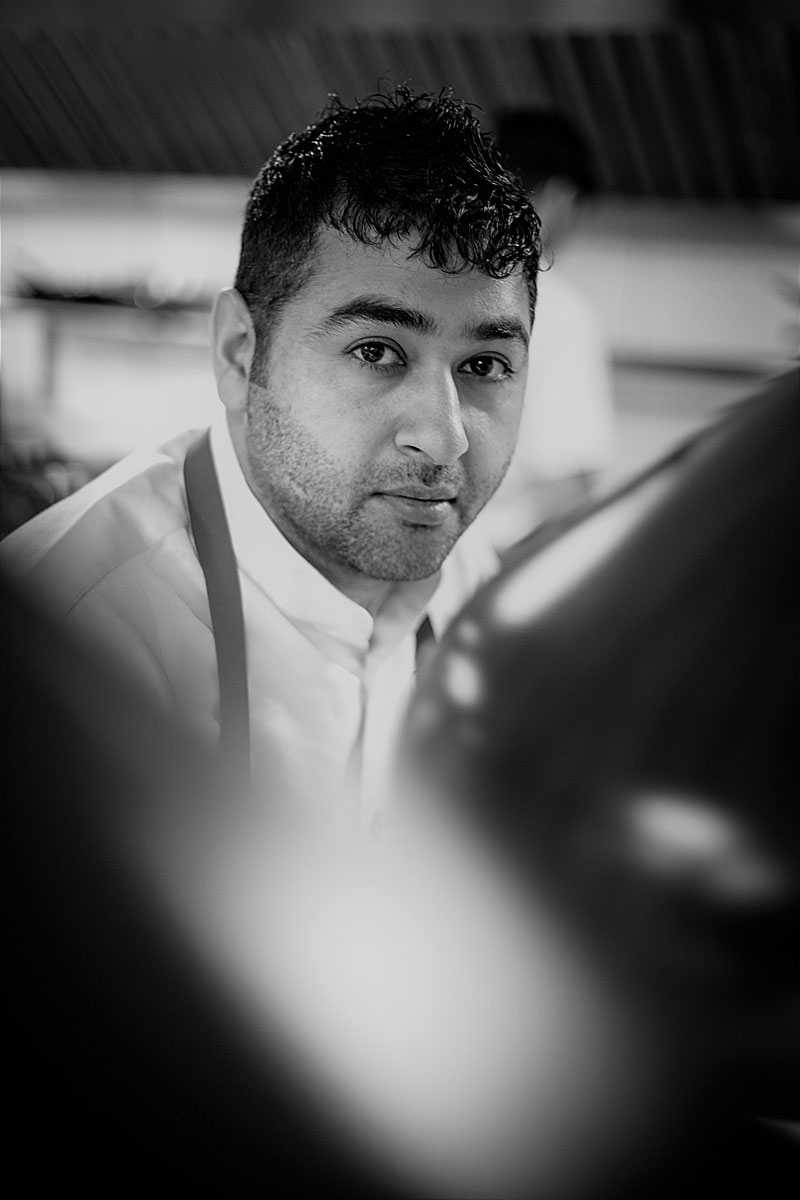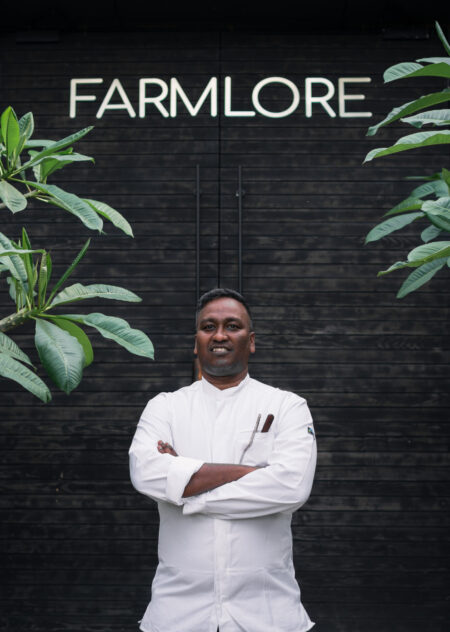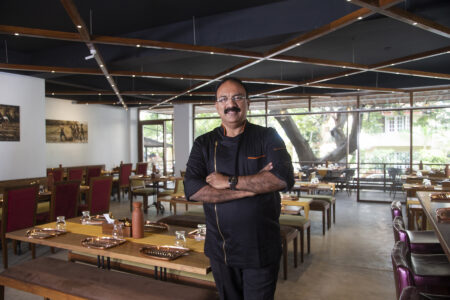Every evening at 7.30, a heavy curtain parts at the far end of the ultra-modern Indian restaurant, Masque, and the service begins. Co-owned by Chef Prateek Sadhu and entrepreneur Aditi Duggar, Masque draws its name from the inherent sense of performance that comes with presenting food, interpreted in the most contemporary, crisp fashion. Kashmir-born Sadhu, who trained at the Culinary Institute of America and worked in some of the most famous kitchens in the world, including Alenia, Le Bernardin, and Noma, focusses on unlocking the essence of uniquely Indian flavours.
Kaveri Ponnapa delves into the inspirations that define Prateek Sadhu’s vision for Masque
Kaveri Ponnapa: Masque is two years old, and continues to offer a constantly evolving tasting menu to guests. What has the journey been like for you and your team? Prateek Sadhu: We have grown, every single day of these two years. We began by breaking down the typical dining experience, elevating it. It needed patience and perseverance. We did not offer an à la carte menu. People were used to making choices, deciding what to eat at restaurants. I have seen days when seated guests would get up and leave when presented with the idea of eating a series of unfamiliar dishes that did not have names, instead of choosing from a menu. But we were able to build interest and trust, and now it’s great to see the reservations sold out several days at a stretch.
KP: The term ‘Indian’ is too diffuse to apply to the dishes that are created at Masque. Do you see a unique way of thinking about cuisine emerging out of the food you cook and present? PS: We need to look at Indian food from new perspectives. I apply the techniques I have learnt to raw materials, and observe the story that unfolds. The dishes at Masque are ingredient driven. We take a single ingredient and pair it with spices and other raw materials, all the while looking at the history of a dish, its essence. It is roots that give definition to a dish. We are constantly distilling our roots into our own, new formats.
KP: Having grown up eating traditional home cooking, you have gone through the process of dislocation, then returning to Kashmir and re-tracing your roots through food. PS: Six months after we opened Masque, I questioned myself about the kind of food I loved to cook and eat —and the answer was, home cooked food. We had to leave Kashmir in the ’90’s and relocate in Delhi. Dried vegetables are a winter necessity in Kashmir; but my mother continued to cook dishes like dried turnips with lamb, and dried fish, when there was no need, when there was so much fresh produce available. Years later, I understood that it was the emotion and connectedness she was re-creating, not just the food. I realized this was the food I wanted to cook, and went back to Kashmir on a journey to re-discover it.
KP: You see yourself anchored by the Himalayas and their ingredients, and speak of keeping the region at the forefront of everything that is created at Masque. PS: When I went back, to Kashmir, I saw dandelion, amaranth, sorrel —all fresh greens that I had seen used in Europe. Here, they were an essential part of our traditional cuisine and I was looking at them from a fresh standpoint. I saw how an entire village would gather in the fields to smoke and dry fish for winter. I learnt to forage for morels, which feature on our menu seasonally. My journey also took me to Ladakh. As we passed the Nubra valley to Turtuk, there were miles of bushes covered in sea buckthorn berries. Every year I make a trip to forage about 100kgs of sea buckthorn which features on our menu for a few months. There was wild lavender, and apricots, which were incorporated into dishes. Roots give you clarity. Retracing my roots through food has definitely given me more confidence in the dishes I create.
KP: What does a recipe mean to you in the context of the way you cook and create dishes? PS: I want diners to experience the flavours of the region, but also explore the different flavour profiles these dishes work with. We are not, after all, a traditional Kashmiri restaurant. The recipes, like the ingredients we use, act as a launch pad for the dishes. I experiment with new directions in which we can take them. It’s part preservation, part innovation.
KP: In the search for ingredients, you have probably visited many markets in the Himalayas and the elsewhere in the country. Which is one that stands out, one that you would return to, and why? PS: So many! One is the floating market on the Dal Lake. You take a shikara to the middle of the lake, and from the early hours of the morning, you will see 50-60 growers coming together to sell their produce. It’s one of the few floating markets of the world, and a spectacular sight. Another is in Arunachal Pradesh, where farmers come together to sell foraged seasonal vegetables and greens that they trek distances and hunt for each morning before they set up at the market. Both stand out for being uniquely rooted in their locales.
KP: You have a dream to create a R&D lab, where experimentation and innovation can be done in the use of raw materials. What is the significance of such a concept for India? PS: The Indian food space is on the brink of a massive change, and R&D is the next stage needed to push it forward. There is a real need to create research and development hubs where the textures, flavours and inherent properties of every ingredient can be researched in depth.
KP: Masque has an incredibly young team. Their involvement is visible at every level, from the kitchen to the restaurant floor. What is the one talent or resource that you would like to add to your kitchen? PS: Young and so talented! We tried to build a relatively young team that is open to new ideas and constant learning. A resource I’d like to add is people with a background in science, who can be dedicated to working on the chemistry and biology of ingredients so that we can bring that information into the kitchen, and to our diners.
KP: René Redzepi has spoken of Mexico and its cuisine as a “giant waiting to be awakened”. Having visited and cooked in Mexico City and Yucatan yourself, would you say this also true of India? PS: Absolutely. I believe we are on the cusp of becoming a huge ‘food destination’ internationally. The sheer diversity of regional flavours, techniques and traditions have so much to offer. It’s still at a nascent stage, but it is very exciting to see the kind of work that is developing in the space. We are extremely fortunate to live and eat in a country that produces the kind of ingredients and raw materials it does, and we need to make sure we tap into it.
KP: What are some of the ingredients and raw materials we can expect to see you working with more, in 2019? PS: We plan to explore more of the north-east. It’s a region I have not yet experienced fully, and I’m excited to incorporate its produce in this year’s menus.
 Dining at Masque
Dining at Masque
Masque works in rhythm with the seasons, its kitchen supplied with fresh produce grown at a dedicated farm close to Pune, in addition to the ultra-local ingredients sourced from the Himalayan belt including Kashmir, Ladakh and Uttarakhand. Over a 10-course tasting menu, traditional recipes and ingredients are re-imagined, and often challenge our perceptions; but presentations apart, it is the impact of the intensity of flavours that stays after each dish has been consumed. At dinner, you might get a cup of yakhni, its surface dotted with aromatic spruce oil that immediately evokes the mountains, alongside exquisitely tender free-range quail; or Kashmiri ver (a spiced rice porridge made on special occasions), quite different from, yet recognizably linked to the original. In this case, ver cooked in a broth of turnips and mushrooms, with morels, walnuts, mustard oil, topped with crispy amaranth leaves, the whole creation like a steamy, moist, leaf-covered forest floor, releasing layer after layer of flavour. Depending on the time of year, you might find any one of these dishes on your table:
—Succulent filets of smoked mackerel on buckwheat toast, with garlic and chilli paste
—Flavour focussed, textured lamb harissa, with aromatic hot mustard oil and rice crackers
— Brined and cured Barramundi in a coconut and kaffir lime broth with radish and green mango, the sharp citrus cutting through, and adding an element of freshness to the cold, spiced soup
— Pista cake with orange skin, dill leaf, served with honey ice cream, beetroot and orange juice 
MASQUE RESTAURANT
UNIT G3, LAXMI WOOLLEN MILLS, SHAKTI MILLS LANE, OFF DR. E. MOSES ROAD
MAHALAXMI, MUMBAI 400011
TELEPHONE
022 4973 7431/32 | 98190 69222
By: Kaveri Ponnapa
Image credits: Masque Restaurant
This article was published in Sommelier India Magazine, Volume 15: Issue 2, April-June 2019 www.sommelierindia.com




